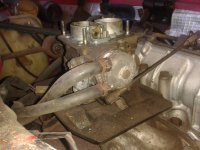Weber vs Dellorto copied from Lotus site (I have Esprit with Dellotos on it.)
Once set up, there's probably little difference between the performance potential of Weber DCOE and
Dellorto DHLA carbs; however, they're not simply different flavors of the same taffy. There are differences between them, and for my money, I prefer Dellortos. I'm not trying to start a debate. If you like Webers, use them.
Dellorto calibration parts, like jets and mixture screws, offer much finer resolution. Weber Main Jets are available in size steps of five (130, 135, 140...) while Dellorto's are available in steps of one (131, 132, 133, 134...). Same with Idle Jets,
Accelerator Pump Jets, etc...
The Weber Idle Mixture Screws have blunt tapers and coarse threads, while Dellorto's have long slender needles and fine threads. Then later, the "E" models (40E & 45E) got even longer tapered needles and finer threads. Weber mixture screws usually end up adjusted about 1 1/4 - 2 1/4 turns out, while
Dellorto screws end up 2 3/4 - 3 3/4 turns out.
Overall, it's much easier to sneak up on a very exact mixture setting with Dellortos, while you just sort of take big steps with Webers.
The Weber progression circuit often has only 2 or 3 holes, while
Dellortos have 5 or 6. The
Dellorto 6-hole progression is a Lotus development for their own models which Dellorto later adopted across it's own main product line.
The 6-hole setup gives the Dellorto a much smoother progression off-idle so the carbs depend less upon a heavy shot from the accelerator pump. The Weber, on the other hand, uses a big pump shot. So much so that Weber carbed engines often deliver significantly shorter piston ring life compared to their Dellorto/ Stromberg counterparts due to the Weber pump shot washing down the cylinder walls all the time.
The Weber accelerator pump's piston runs in a bore machined into the body. It's metal to metal, is subject to "blow-by" do to clearances, tends to wear over time, and the bore can't be repaired. On the other hand, the Dellorto diaphragm pump has no blow-by and clearances don't wear with use. Then when it does get old, the pump is easily rebuildable back to 100% spec by simply replacing the diaphragm and gasket.
Weber's are more prone to leak. I'm not saying that they all leak, just that they're more prone to leak. I have three Lotus engines with pairs of DHLAs, and they "never" leak, and they don't smell of gas any more than is typical of a normal carb (ie, vented float bowls). The
Webers in the other car are always having leak issues and the car wreaks of gas.
Someone I know at Lotus Cars once told me switching to Dellortos was Lotus' answer for solving persistent fuel leak issues.
Regards,
Tim Engel



